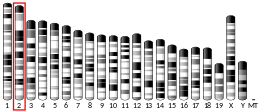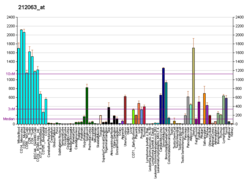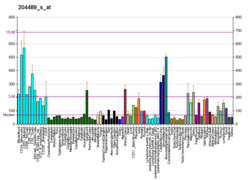TheCD44 antigenis acell-surfaceglycoproteininvolved in cell–cell interactions, cell adhesion and migration. In humans, the CD44 antigen is encoded by theCD44geneon chromosome 11.[5]CD44 has been referred to as HCAM (homingcell adhesion molecule), Pgp-1 (phagocyticglycoprotein-1), Hermes antigen, lymphocyte homing receptor, ECM-III, and HUTCH-1.
Tissue distribution and isoforms
editCD44 is expressed in a large number of mammalian cell types. The standardisoform,designated CD44s, comprisingexons1–5 and 16–20 is expressed in most cell types. CD44 splice variants containing variable exons are designated CD44v. Someepithelial cellsalso express a larger isoform (CD44E), which includes exons v8–10.[6]
Function
editCD44 participates in a wide variety of cellular functions includinglymphocyteactivation, recirculation and homing,hematopoiesis,andtumormetastasis.
CD44 is a receptor forhyaluronic acid[7]and internalizes metals bound to hyaluronic acid[8][9]and can also interact with otherligands,such asosteopontin,collagens,andmatrix metalloproteinases(MMPs). CD44 function is controlled by its posttranslational modifications. One critical modification involves discrete sialofucosylations rendering the selectin-binding glycoform of CD44 called HCELL (for Hematopoietic Cell E-selectin/L-selectin Ligand).[10](see below)
Transcripts for thisgeneundergo complexalternative splicingthat results in many functionally distinctisoforms;however, the full length nature of some of these variants has not been determined. Alternative splicing is the basis for the structural and functional diversity of this protein, and may be related to tumor metastasis. Splice variants of CD44 on colon cancer cells display sialofucosylated HCELL glycoforms that serve as P-, L-, and E-selectin ligands and fibrin, but not fibrinogen, receptors under hemodynamic flow conditions pertinent to the process of cancer metastasis.[11][12]
CD44 genetranscriptionis at least in part activated bybeta-cateninandWnt signalling(also linked to tumour development).
HCELL
editThe HCELL glycoform was originally discovered on human hematopoietic stem cells and leukemic blasts,[10][13][14][15]and was subsequently identified on cancer cells.[12][16][17][18][19]HCELL functions as a "bonehomingreceptor ", directing migration of human hematopoietic stem cells andmesenchymal stem cellsto bone marrow.[14]Ex vivo glycan engineering of the surface of live cells has been used to enforce HCELL expression on any cell that expresses CD44.[20]CD44 glycosylation also directly controls its binding capacity to fibrin and immobilized fibrinogen.[11][21]
Clinical significance
editThe protein is a determinant for theIndian blood group system.
- CD44, along withCD25,is used to track earlyT celldevelopment in thethymus.
- CD44 expression is an indicative marker for effector-memory T-cells. Memory cell proliferation (activation) can also be assayedin vitrowithCFSEchemical tagging.
In addition, variations in CD44 are reported as cell surface markers for some breast and prostatecancer stem cells.In breast cancer research CD44+/CD24- expression is commonly used as a marker for breast CSCs and is used to sort breast cancer cells into a population enriched in cells with stem-like characteristics[22]and has been seen as an indicator of increased survival time inepithelialovarian cancerpatients.[23]
Endometrial cells in women withendometriosisdemonstrate increased expression of splice variants of CD44, and increased adherence to peritoneal cells.[24]
CD44 variantisoformsare also relevant to the progression ofhead and neck squamous cell carcinoma.[25][26]
Monoclonal antibodiesagainst CD44 variants includebivatuzumabfor v6.
CD44 in cancer
editCD44 is a multistructural and multifunctionalcell surface moleculeinvolved incell proliferation,cell differentiation,cell migration,angiogenesis,presentation ofcytokines,chemokines,and growth factors to the correspondingreceptors,and docking ofproteasesat thecell membrane,as well as in signaling forcell survival.All these biological properties are essential to the physiological activities of normal cells, but they are also associated with the pathologic activities ofcancer cells.Experiments in animals have shown that targeting of CD44 byantibodies,antisenseoligonucleotides, and CD44-soluble proteins markedly reduces the malignant activities of variousneoplasms,stressing the therapeutic potential of anti-CD44 agents.
High levels of the adhesion molecule CD44 on leukemic cells are essential to generate leukemia.[27]Furthermore, becausealternative splicingandposttranslational modificationsgenerate many different CD44 sequences, including, perhaps, tumor-specific sequences, the production of anti-CD44 tumor-specific agents may be a realistic therapeutic approach.[28]
In many cancers (renal cancerandnon-Hodgkin's lymphomasare exceptions), a high level of CD44 expression is not always associated with an unfavorable outcome.[29]On the contrary, in some neoplasms CD44upregulationis associated with a favorable outcome. This is true ofprostate cancer,where thetranscript variantCD44v5 (includes the fifth 'v5' exon) is associated with better prognosis (increased time to recurrence following surgery).[30][29]In prostate cancer, the exclusion of the v5 exon through alternative splicing was associated with the presence of RNA binding proteinKHDRBS1and became included in the presence of increasedYTHDC1ormetadherinexpression.[30]
In other cases different research groups analyzing the same neoplastic disease reached contradictory conclusions regarding the correlation between CD44 expression and disease prognosis, possibly due to differences in methodology. These problems must be resolved before applying anti-CD44 therapy to human cancers.[29]
Interactions
editCD44 has been shown tointeractwith:
References
edit- ^abcGRCh38: Ensembl release 89: ENSG00000026508–Ensembl,May 2017
- ^abcGRCm38: Ensembl release 89: ENSMUSG00000005087–Ensembl,May 2017
- ^"Human PubMed Reference:".National Center for Biotechnology Information, U.S. National Library of Medicine.
- ^"Mouse PubMed Reference:".National Center for Biotechnology Information, U.S. National Library of Medicine.
- ^Spring FA, Dalchau R, Daniels GL, Mallinson G, Judson PA, Parsons SF, et al. (May 1988)."The Ina and Inb blood group antigens are located on a glycoprotein of 80,000 MW (the CDw44 glycoprotein) whose expression is influenced by the In(Lu) gene".Immunology.64(1):37–43.PMC1385183.PMID2454887.
- ^Goodison S, Urquidi V, Tarin D (August 1999)."CD44 cell adhesion molecules".Molecular Pathology.52(4):189–196.doi:10.1136/mp.52.4.189.PMC395698.PMID10694938.
- ^Aruffo A, Stamenkovic I, Melnick M, Underhill CB, Seed B (June 1990). "CD44 is the principal cell surface receptor for hyaluronate".Cell.61(7):1303–1313.doi:10.1016/0092-8674(90)90694-a.PMID1694723.S2CID8217636.
- ^Müller S, Sindikubwabo F, Cañeque T, Lafon A, Versini A, Lombard B, et al. (October 2020)."CD44 regulates epigenetic plasticity by mediating iron endocytosis".Nature Chemistry.12(10):929–938.Bibcode:2020NatCh..12..929M.doi:10.1038/s41557-020-0513-5.PMC7612580.PMID32747755.
- ^Solier S, Müller S, Cañeque T, Versini A, Mansart A, Sindikubwabo F, et al. (May 2023)."A druggable copper-signalling pathway that drives inflammation".Nature.617(7960):386–394.Bibcode:2023Natur.617..386S.doi:10.1038/s41586-023-06017-4.PMC10131557.PMID37100912.
- ^abOxley SM, Sackstein R (November 1994)."Detection of an L-selectin ligand on a hematopoietic progenitor cell line".Blood.84(10):3299–3306.doi:10.1182/blood.V84.10.3299.3299.PMID7524735.
- ^abcAlves CS, Burdick MM, Thomas SN, Pawar P, Konstantopoulos K (April 2008). "The dual role of CD44 as a functional P-selectin ligand and fibrin receptor in colon carcinoma cell adhesion".American Journal of Physiology. Cell Physiology.294(4):C907 –C916.doi:10.1152/ajpcell.00463.2007.PMID18234849.S2CID31373618.
- ^abHanley WD, Burdick MM, Konstantopoulos K, Sackstein R (July 2005)."CD44 on LS174T colon carcinoma cells possesses E-selectin ligand activity".Cancer Research.65(13):5812–5817.doi:10.1158/0008-5472.CAN-04-4557.PMID15994957.
- ^Sackstein R, Dimitroff CJ (October 2000). "A hematopoietic cell L-selectin ligand that is distinct from PSGL-1 and displays N-glycan-dependent binding activity".Blood.96(8):2765–2774.doi:10.1182/blood.V96.8.2765.PMID11023510.
- ^abSackstein R, Merzaban JS, Cain DW, Dagia NM, Spencer JA, Lin CP, et al. (February 2008). "Ex vivo glycan engineering of CD44 programs human multipotent mesenchymal stromal cell trafficking to bone".Nature Medicine.14(2):181–187.doi:10.1038/nm1703.PMID18193058.S2CID5095656.
- ^Dimitroff CJ, Lee JY, Rafii S, Fuhlbrigge RC, Sackstein R (June 2001)."CD44 is a major E-selectin ligand on human hematopoietic progenitor cells".The Journal of Cell Biology.153(6):1277–1286.doi:10.1083/jcb.153.6.1277.PMC2192031.PMID11402070.
- ^Burdick MM, Chu JT, Godar S, Sackstein R (May 2006)."HCELL is the major E- and L-selectin ligand expressed on LS174T colon carcinoma cells".The Journal of Biological Chemistry.281(20):13899–13905.doi:10.1074/jbc.M513617200.PMID16565092.
- ^abHanley WD, Napier SL, Burdick MM, Schnaar RL, Sackstein R, Konstantopoulos K (February 2006)."Variant isoforms of CD44 are P- and L-selectin ligands on colon carcinoma cells".FASEB Journal.20(2):337–339.doi:10.1096/fj.05-4574fje.PMID16352650.S2CID23662591.
- ^abNapier SL, Healy ZR, Schnaar RL, Konstantopoulos K (February 2007)."Selectin ligand expression regulates the initial vascular interactions of colon carcinoma cells: the roles of CD44v and alternative sialofucosylated selectin ligands".The Journal of Biological Chemistry.282(6):3433–3441.doi:10.1074/jbc.M607219200.PMID17135256.
- ^abThomas SN, Zhu F, Schnaar RL, Alves CS, Konstantopoulos K (June 2008)."Carcinoembryonic antigen and CD44 variant isoforms cooperate to mediate colon carcinoma cell adhesion to E- and L-selectin in shear flow".The Journal of Biological Chemistry.283(23):15647–15655.doi:10.1074/jbc.M800543200.PMC2414264.PMID18375392.
- ^Sackstein R (July 2009)."Glycosyltransferase-programmed stereosubstitution (GPS) to create HCELL: engineering a roadmap for cell migration".Immunological Reviews.230(1):51–74.doi:10.1111/j.1600-065X.2009.00792.x.PMC4306344.PMID19594629.
- ^abAlves CS, Yakovlev S, Medved L, Konstantopoulos K (January 2009)."Biomolecular characterization of CD44-fibrin(ogen) binding: distinct molecular requirements mediate binding of standard and variant isoforms of CD44 to immobilized fibrin(ogen)".The Journal of Biological Chemistry.284(2):1177–1189.doi:10.1074/jbc.M805144200.PMC2613610.PMID19004834.
- ^Li F, Tiede B, Massagué J, Kang Y (January 2007)."Beyond tumorigenesis: cancer stem cells in metastasis".Cell Research.17(1):3–14.doi:10.1038/sj.cr.7310118.PMID17179981.
- ^Sillanpää S, Anttila MA, Voutilainen K, Tammi RH, Tammi MI, Saarikoski SV, et al. (November 2003)."CD44 expression indicates favorable prognosis in epithelial ovarian cancer".Clinical Cancer Research.9(14):5318–5324.PMID14614016.
- ^Griffith JS, Liu YG, Tekmal RR, Binkley PA, Holden AE, Schenken RS (April 2010)."Menstrual endometrial cells from women with endometriosis demonstrate increased adherence to peritoneal cells and increased expression of CD44 splice variants".Fertility and Sterility.93(6):1745–1749.doi:10.1016/j.fertnstert.2008.12.012.PMC2864724.PMID19200980.
- ^Wang SJ, Wong G, de Heer AM, Xia W, Bourguignon LY (August 2009)."CD44 variant isoforms in head and neck squamous cell carcinoma progression".The Laryngoscope.119(8):1518–1530.doi:10.1002/lary.20506.PMC2718060.PMID19507218.
- ^Assimakopoulos D, Kolettas E, Patrikakos G, Evangelou A (October 2002). "The role of CD44 in the development and prognosis of head and neck squamous cell carcinomas".Histology and Histopathology.17(4):1269–1281.doi:10.14670/HH-17.1269.PMID12371152.
- ^Quéré R, Andradottir S, Brun AC, Zubarev RA, Karlsson G, Olsson K, et al. (March 2011)."High levels of the adhesion molecule CD44 on leukemic cells generate acute myeloid leukemia relapse after withdrawal of the initial transforming event".Leukemia.25(3):515–526.doi:10.1038/leu.2010.281.PMC3072510.PMID21116281.
- ^Eibl RH, Pietsch T, Moll J, Skroch-Angel P, Heider KH, von Ammon K, et al. (December 1995). "Expression of variant CD44 epitopes in human astrocytic brain tumors".Journal of Neuro-Oncology.26(3):165–170.doi:10.1007/bf01052619.PMID8750182.S2CID21251441.
- ^abcNaor D, Nedvetzki S, Golan I, Melnik L, Faitelson Y (November 2002). "CD44 in cancer".Critical Reviews in Clinical Laboratory Sciences.39(6):527–579.doi:10.1080/10408360290795574.PMID12484499.S2CID30019668.
- ^abLuxton HJ, Simpson BS, Mills IG, Brindle NR, Ahmed Z, Stavrinides V, et al. (August 2019)."The Oncogene Metadherin Interacts with the Known Splicing Proteins YTHDC1, Sam68 and T-STAR and Plays a Novel Role in Alternative mRNA Splicing".Cancers.11(9): 1233.doi:10.3390/cancers11091233.PMC6770463.PMID31450747.
- ^Bourguignon LY, Singleton PA, Zhu H, Diedrich F (August 2003)."Hyaluronan-mediated CD44 interaction with RhoGEF and Rho kinase promotes Grb2-associated binder-1 phosphorylation and phosphatidylinositol 3-kinase signaling leading to cytokine (macrophage-colony stimulating factor) production and breast tumor progression".The Journal of Biological Chemistry.278(32):29420–29434.doi:10.1074/jbc.M301885200.PMID12748184.
- ^Chen X, Khajeh JA, Ju JH, Gupta YK, Stanley CB, Do C, et al. (March 2015)."Phosphatidylinositol 4,5-bisphosphate clusters the cell adhesion molecule CD44 and assembles a specific CD44-Ezrin heterocomplex, as revealed by small angle neutron scattering".The Journal of Biological Chemistry.290(10):6639–6652.doi:10.1074/jbc.M114.589523.PMC4358296.PMID25572402.
- ^Midgley AC, Rogers M, Hallett MB, Clayton A, Bowen T, Phillips AO, et al. (May 2013)."Transforming growth factor-β1 (TGF-β1)-stimulated fibroblast to myofibroblast differentiation is mediated by hyaluronan (HA)-facilitated epidermal growth factor receptor (EGFR) and CD44 co-localization in lipid rafts".The Journal of Biological Chemistry.288(21):14824–14838.doi:10.1074/jbc.M113.451336.PMC3663506.PMID23589287.
- ^Jalkanen S, Jalkanen M (February 1992)."Lymphocyte CD44 binds the COOH-terminal heparin-binding domain of fibronectin".The Journal of Cell Biology.116(3):817–825.doi:10.1083/jcb.116.3.817.PMC2289325.PMID1730778.
- ^abIlangumaran S, Briol A, Hoessli DC (May 1998)."CD44 selectively associates with active Src family protein tyrosine kinases Lck and Fyn in glycosphingolipid-rich plasma membrane domains of human peripheral blood lymphocytes".Blood.91(10):3901–3908.doi:10.1182/blood.V91.10.3901.PMID9573028.
- ^Aruffo A, Stamenkovic I, Melnick M, Underhill CB, Seed B (June 1990). "CD44 is the principal cell surface receptor for hyaluronate".Cell.61(7):1303–1313.doi:10.1016/0092-8674(90)90694-A.PMID1694723.S2CID8217636.
- ^Taher TE, Smit L, Griffioen AW, Schilder-Tol EJ, Borst J, Pals ST (February 1996)."Signaling through CD44 is mediated by tyrosine kinases. Association with p56lck in T lymphocytes".The Journal of Biological Chemistry.271(5):2863–2867.doi:10.1074/jbc.271.5.2863.PMID8576267.
- ^Zohar R, Suzuki N, Suzuki K, Arora P, Glogauer M, McCulloch CA, et al. (July 2000). "Intracellular osteopontin is an integral component of the CD44-ERM complex involved in cell migration".Journal of Cellular Physiology.184(1):118–130.doi:10.1002/(SICI)1097-4652(200007)184:1<118::AID-JCP13>3.0.CO;2-Y.PMID10825241.S2CID11548419.
- ^Bourguignon LY, Zhu H, Shao L, Chen YW (March 2001)."CD44 interaction with c-Src kinase promotes cortactin-mediated cytoskeleton function and hyaluronic acid-dependent ovarian tumor cell migration".The Journal of Biological Chemistry.276(10):7327–7336.doi:10.1074/jbc.M006498200.PMID11084024.
- ^Shi X, Leng L, Wang T, Wang W, Du X, Li J, et al. (October 2006)."CD44 is the signaling component of the macrophage migration inhibitory factor-CD74 receptor complex".Immunity.25(4):595–606.doi:10.1016/j.immuni.2006.08.020.PMC3707630.PMID17045821.
Further reading
edit- Sackstein R (July 2011)."The biology of CD44 and HCELL in hematopoiesis: the 'step 2-bypass pathway' and other emerging perspectives".Current Opinion in Hematology.18(4):239–248.doi:10.1097/MOH.0b013e3283476140.PMC3145154.PMID21546828.
- Sackstein R (July 2009)."Glycosyltransferase-programmed stereosubstitution (GPS) to create HCELL: engineering a roadmap for cell migration".Immunological Reviews.230(1):51–74.doi:10.1111/j.1600-065X.2009.00792.x.PMC4306344.PMID19594629.
- Sackstein R (May 2004)."The bone marrow is akin to skin: HCELL and the biology of hematopoietic stem cell homing".The Journal of Investigative Dermatology.122(5):1061–1069.doi:10.1111/j.0022-202X.2004.09301.x.PMID15140204.
- Konstantopoulos K, Thomas SN (2009)."Cancer cells in transit: the vascular interactions of tumor cells".Annual Review of Biomedical Engineering.11:177–202.doi:10.1146/annurev-bioeng-061008-124949.PMID19413512.
- Günthert U (1993). "CD44: A Multitude of Isoforms with Diverse Functions".Adhesion in Leukocyte Homing and Differentiation(PDF).Current Topics in Microbiology and Immunology. Vol. 184. pp.47–63.doi:10.1007/978-3-642-78253-4_4.ISBN978-3-642-78255-8.PMID7508842.
- Yasuda M, Nakano K, Yasumoto K, Tanaka Y (2003). "CD44: functional relevance to inflammation and malignancy".Histology and Histopathology.17(3):945–950.doi:10.14670/HH-17.945.PMID12168806.
- Sun CX, Robb VA, Gutmann DH (November 2002). "Protein 4.1 tumor suppressors: getting a FERM grip on growth regulation".Journal of Cell Science.115(Pt 21):3991–4000.doi:10.1242/jcs.00094.PMID12356905.S2CID14243743.
- Ponta H, Sherman L, Herrlich PA (January 2003). "CD44: from adhesion molecules to signalling regulators".Nature Reviews. Molecular Cell Biology.4(1):33–45.doi:10.1038/nrm1004.PMID12511867.S2CID19495756.
- Martin TA, Harrison G, Mansel RE, Jiang WG (May 2003). "The role of the CD44/ezrin complex in cancer metastasis".Critical Reviews in Oncology/Hematology.46(2):165–186.doi:10.1016/S1040-8428(02)00172-5.PMID12711360.
External links
edit- Indian blood group systematBGMUTBlood Group Antigen Gene Mutation Database atNCBI,NIH
- ArticlesatIHOP.
- HumanCD44genome location andCD44gene details page in theUCSC Genome Browser.







